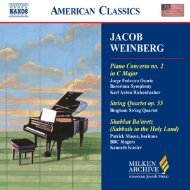Download Liner Notes PDF - Milken Archive of Jewish Music
Download Liner Notes PDF - Milken Archive of Jewish Music
Download Liner Notes PDF - Milken Archive of Jewish Music
Create successful ePaper yourself
Turn your PDF publications into a flip-book with our unique Google optimized e-Paper software.
music program at Newark’s prestigious B’nai Abraham,<br />
where he found it fulfilling to work with Abraham<br />
Shapiro, an important cantor <strong>of</strong> the time, and with<br />
that synagogue’s esteemed scholar, author, and rabbi,<br />
Joachim Prinz, who had been one <strong>of</strong> Berlin’s leading<br />
rabbinical personalities. From the late 1930s on, he<br />
turned much <strong>of</strong> his attention to new settings for<br />
Sabbath, High Holy Day, and Festival liturgies, as well<br />
as for other services. His choral pantomime Benjamin<br />
the Third, based on a story by the famous Yiddish<br />
author Mendele Moykher Sforim, was premiered at<br />
Carnegie Hall in 1938, as was his complete Sabbath<br />
service, Shabbat Kodesh (Holy Sabbath) in 1942. For<br />
a two-year period he also directed the Handel Choir<br />
<strong>of</strong> Westfield, New York, where he concentrated on<br />
classical—especially Baroque—repertoire.<br />
Still, no consideration <strong>of</strong> Helfman can ignore his<br />
involvement as director <strong>of</strong> New York’s largest<br />
unabashedly leftist Yiddish chorus, the Freiheits Gezang<br />
Verein, which he took over in 1937 and which combined<br />
with some smaller choral groups <strong>of</strong> similar ideological<br />
sympathies to form the <strong>Jewish</strong> People’s Philharmonic<br />
Chorus. Founded as a worker’s chorus in the 1920s by<br />
Jacob Schaefer following his initial establishment <strong>of</strong> a<br />
similar chorus in Chicago (accounts and dates vary), its<br />
internal orientation and its acknowledged public persona<br />
were “left-wing Yiddishist” at the minimum—far to the<br />
left <strong>of</strong> the more benignly socialist organizations such as<br />
the Workmen’s Circle or the Labor-Zionist Farband and<br />
their choruses. The <strong>Jewish</strong> People’s Philharmonic Chorus<br />
was loosely federated under the national umbrella <strong>of</strong><br />
the <strong>Jewish</strong> Workers <strong>Music</strong>al Alliance, which included<br />
Freiheits Gezang Verein affiliates in nearly thirty cities,<br />
directed by such conductors as Paul Held, Eugene Malek,<br />
Vladimir Heifetz, and Mendy Schein.<br />
By the end <strong>of</strong> the 20th century, many <strong>of</strong> the aging<br />
alumni <strong>of</strong> Freiheits choruses from that era (at least<br />
through the 1950s) <strong>of</strong>ten preferred to remember them<br />
as “humanistically” oriented groups <strong>of</strong> “the folk.”<br />
But in fact they were commonly, if informally, known<br />
all during that period as the “communist Yiddish<br />
choruses,” or at least communist-leaning—labels they<br />
made no particular effort to reject or protest. That<br />
phenomenon must be understood in the context <strong>of</strong> the<br />
times, which involved general working-class concerns,<br />
utopian sentiments, and, especially during the 1930s,<br />
simply antifascism—but not necessarily political or<br />
ideological anti-Americanism or even anticapitalism.<br />
For some, the interjection “people’s” in the name was<br />
indeed a euphemism for actual communist sympathy,<br />
as it was in the world generally, whether naïvely or<br />
consciously deliberated. For others it simply signified<br />
a “folk chorus” whose repertoire was folk theme, folk<br />
literature, and folksong based.<br />
What that “communist/leftist” identification actually<br />
meant—the degree to which those choruses actually<br />
represented political or party commitment—poses a<br />
complicated question that has yet to be studied on a<br />
scholarly plane. On one level, naïve embrace even <strong>of</strong><br />
the Soviet Union as a “new order” and especially as<br />
the bulwark against the Fascists was certainly evident<br />
in some <strong>of</strong> the programmed concert selections. But no<br />
one has ever ascertained the actual voting patterns<br />
<strong>of</strong> the choristers. It is entirely possible that for many<br />
chorus members it was more a kind <strong>of</strong> cultural<br />
communism on an emotional plane than a political<br />
commitment that attracted them.<br />
Nor is there any way to know Helfman’s motivation<br />
behind his directorship <strong>of</strong> the Freiheits chorus—to<br />
what extent it reveals any particular sympathies, or<br />
to what extent it represented anything more than<br />
a job and another good choral opportunity. At the<br />
time, it was considered a fairly prestigious position<br />
in New York circles, one held previously by no less<br />
an artist than Lazar Weiner. Jacob Schaefer too had<br />
been well respected musically, despite whatever<br />
political leanings he may have had. Nonetheless, the<br />
association did unfairly color some people’s views <strong>of</strong><br />
Helfman and his music for a number <strong>of</strong> years, at least<br />
until he more or less shelved not only the chorus but<br />
most <strong>of</strong> his Yiddishist interests in favor <strong>of</strong> Zionist and<br />
Hebrew cultural perspectives.<br />
8.559440<br />
Helfman_<strong>Liner</strong>Nts 9440.indd 5<br />
12/5/05 1:03:50 PM
















